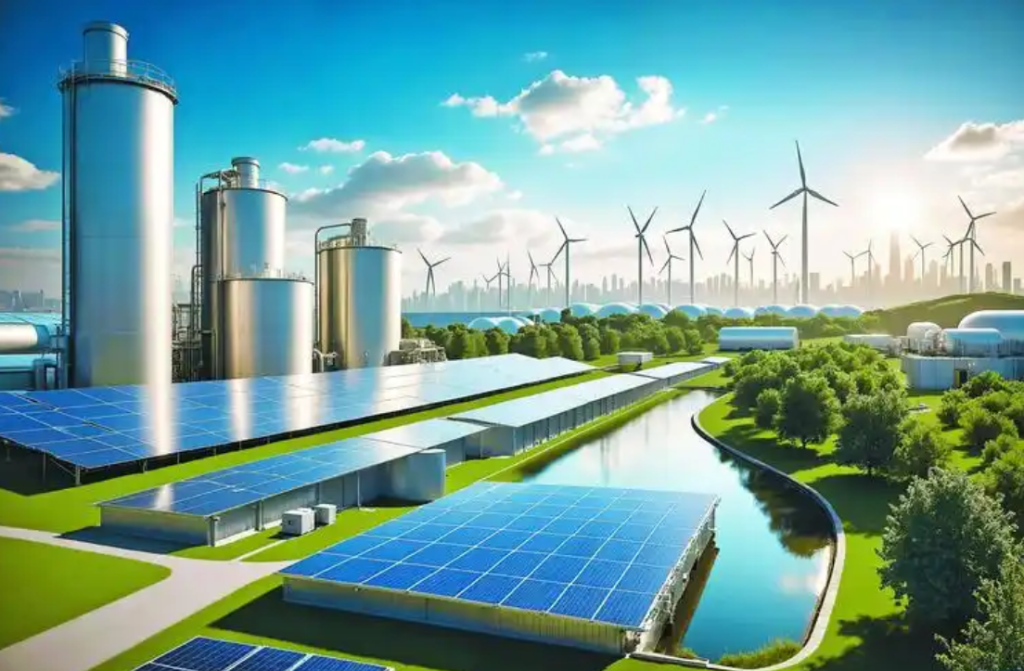Application of Graphene Electrodes in Hydrogen Production Electrolyzers
Hydrogen production via water electrolysis is a cornerstone technology in the transition to renewable energy. Electrolyzers, which split water into hydrogen and oxygen using electricity, rely heavily on the performance of electrodes to achieve high efficiency, durability, and scalability. Graphene, with its unique electrical, thermal, and mechanical properties, has emerged as a transformative material for electrode design in electrolyzers. This article explores the role of graphene electrodes in hydrogen production, detailing their advantages, mechanisms, and recent advancements.

Challenges in Conventional Electrodes for Electrolyzers
- High Overpotential:
- Significant energy is lost due to high overpotential during hydrogen evolution (HER) and oxygen evolution reactions (OER).
- Catalyst Degradation:
- Electrode catalysts, often based on precious metals like platinum or iridium, degrade over time, reducing efficiency.
- Limited Conductivity:
- Traditional electrode materials have suboptimal conductivity, which hampers reaction kinetics.
- Corrosion and Stability:
- Electrodes exposed to harsh electrolytic environments experience corrosion, affecting long-term performance.
Advantages of Graphene Electrodes
Graphene offers several advantages over conventional materials for electrolyzer electrodes:
- High Electrical Conductivity:
- Facilitates efficient electron transfer, enhancing the kinetics of HER and OER.
- Large Surface Area:
- Provides abundant active sites for catalytic reactions, increasing hydrogen production efficiency.
- Corrosion Resistance:
- Exhibits excellent chemical stability, even in harsh acidic or alkaline environments.
- Mechanical Strength:
- Ensures durability under mechanical stress and extended operation.
- Catalyst Support:
- Acts as an ideal support for precious and non-precious metal catalysts, preventing agglomeration and enhancing activity.
- Scalability and Customization:
- Can be fabricated into various forms, including films, foams, and composites, for specific electrolyzer designs.
Applications of Graphene in Electrolyzer Electrodes
1. Graphene-Based Catalyst Electrodes
- Mechanism:
- Graphene serves as a conductive substrate for catalysts, such as platinum, enhancing their distribution and activity.
- Example:
- Platinum nanoparticles supported on graphene showed a 50% reduction in overpotential compared to traditional electrodes.
2. Metal-Free Graphene Electrodes
- Mechanism:
- Functionalized graphene with dopants (e.g., nitrogen, sulfur) exhibits intrinsic catalytic activity for HER and OER.
- Example:
- Nitrogen-doped graphene electrodes achieved comparable HER performance to platinum electrodes in alkaline electrolytes.
3. Graphene-Metal Oxide Composites
- Mechanism:
- Graphene combined with metal oxides, such as NiFe2_2O4_4, provides synergistic effects, enhancing both conductivity and catalytic activity.
- Example:
- Graphene-NiFe2_2O4_4 electrodes exhibited excellent OER performance with low overpotential in alkaline water electrolysis.
4. 3D Graphene Foam Electrodes
- Mechanism:
- 3D graphene foams offer a porous structure, maximizing active sites and improving gas diffusion.
- Example:
- 3D graphene foam electrodes demonstrated higher hydrogen production rates than planar electrodes.
5. Graphene-Coated Electrodes
- Mechanism:
- Graphene coatings protect base materials (e.g., nickel) from corrosion while maintaining excellent conductivity.
- Example:
- Nickel electrodes coated with graphene showed improved durability and efficiency in alkaline electrolyzers.
Key Performance Metrics
- Reduced Overpotential:
- Graphene-based electrodes achieve lower overpotentials for HER and OER due to enhanced electron transfer and active site availability.
- Enhanced Stability:
- Corrosion-resistant graphene ensures stable performance over extended operational periods, reducing maintenance costs.
- Improved Energy Efficiency:
- By reducing energy losses in electrolysis, graphene electrodes contribute to higher overall efficiency.
- Cost Reduction:
- Graphene enables the use of less expensive non-precious metal catalysts while maintaining high performance.
Recent Advances
- Nitrogen-Doped Graphene for HER
- Achieved HER overpotentials of <100 mV in alkaline media, with durability over 1,000 cycles.
- Graphene-Molybdenum Sulfide (MoS2_2) Composites
- Graphene supported MoS2_2 catalysts demonstrated excellent HER performance, rivaling platinum.
- Self-Assembled Graphene Aerogels
- Aerogel electrodes offered high porosity and conductivity, significantly improving hydrogen production rates.
- Hybrid Graphene-TiO2_2 Electrodes
- TiO2_2 nanoparticles on graphene enhanced photocatalytic HER under solar illumination, combining electrolysis with renewable energy.
Challenges and Future Directions
- Scalable Production:
- Cost-effective and scalable methods for synthesizing high-quality graphene remain a bottleneck.
- Integration with Renewable Energy:
- Combining graphene-based electrolyzers with solar or wind energy systems is a promising area of research.
- Long-Term Stability:
- Further studies are needed to ensure graphene’s stability under extreme operational conditions.
- Material Optimization:
- Research into doping, functionalization, and hybridization can further enhance graphene’s performance as an electrode material.
- Economic Feasibility:
- Reducing the cost of graphene production and integrating it into existing electrolyzer systems is crucial for commercialization.
Conclusion
Graphene electrodes are revolutionizing hydrogen production electrolyzers by addressing critical challenges such as high overpotential, catalyst degradation, and stability issues. Their unique properties, including high conductivity, large surface area, and chemical stability, make them ideal for next-generation electrolysis systems.
As research progresses, the integration of graphene electrodes with advanced catalysts and renewable energy sources promises to unlock new levels of efficiency and scalability, accelerating the adoption of hydrogen as a sustainable energy carrier.

